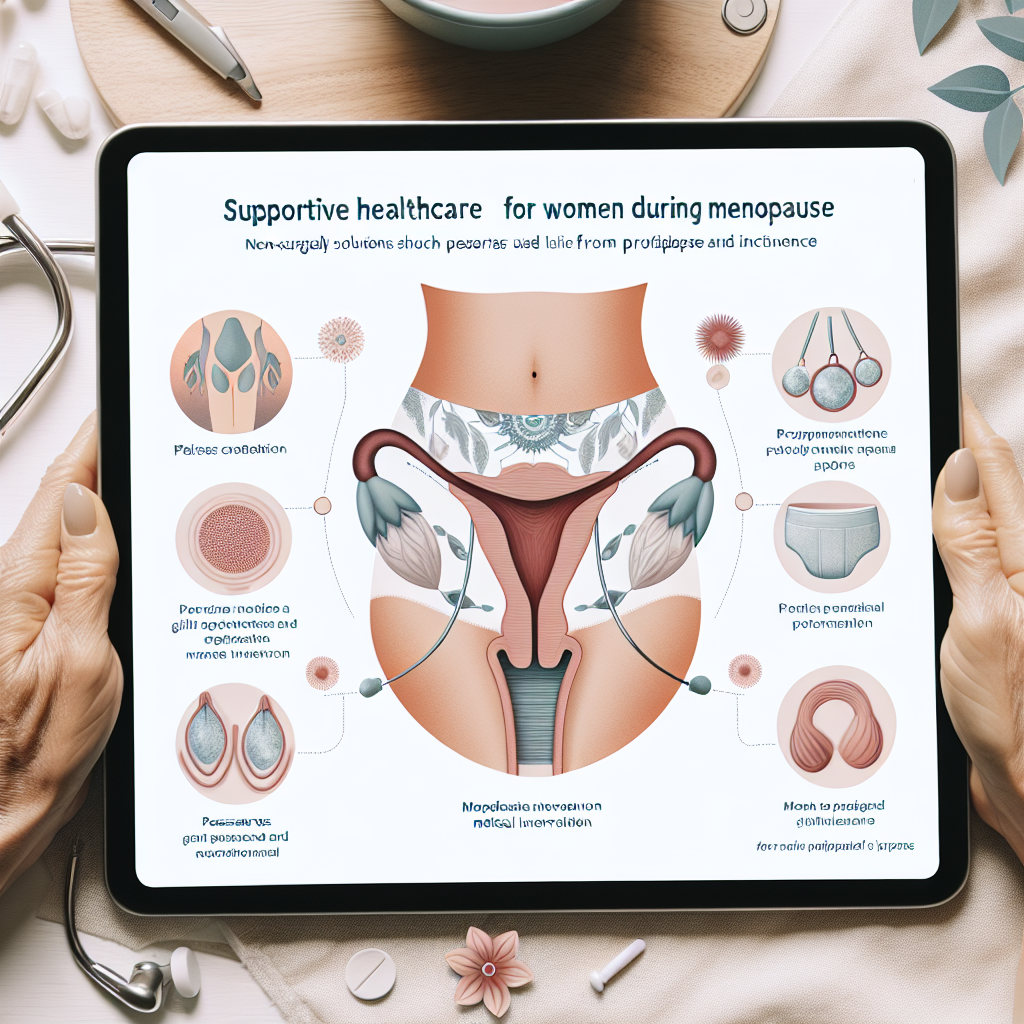Pessaries for Menopause: A Friendly Guide to This Helpful Tool for Women's Health
Ladies, let's talk about something that doesn't get nearly enough airtime in our conversations about menopause: pessaries! If you're scratching your head wondering, "What on earth is a pessary?" don't worry—you're not alone. These nifty devices might just be the unsung heroes of menopause management that you haven't heard about yet.
What Exactly Is a Pessary, Anyway?
Think of a pessary as a supportive friend for your pelvic organs. Technically speaking, a pessary is a removable device inserted into the vagina to provide support to pelvic structures that may have weakened over time. They come in various shapes and sizes—rings, cubes, dishes, and more—each designed for specific needs.
During menopause, our bodies go through significant changes as estrogen levels decline. One consequence many women experience is pelvic organ prolapse, where the bladder, uterus, or rectum may descend into the vaginal canal. This is where pessaries for menopause come into play—they help keep everything where it belongs!
Why Might You Need a Pessary During Menopause?
Menopause brings many gifts (hello, no more periods!), but it also comes with some challenges. As estrogen decreases, the tissues that support our pelvic organs can weaken. According to a study published in the Journal of Women's Health, up to 50% of women will experience some degree of pelvic organ prolapse in their lifetime, with the risk increasing after menopause.
Common reasons women turn to pessaries for menopause support include:
- Urinary incontinence: That annoying leakage when you laugh, sneeze, or exercise
- Pelvic organ prolapse: When organs shift from their normal position
- Uterine retroversion: When the uterus tilts backward
- Support after pelvic surgery: Helping tissues heal properly
Dr. Jane Smith, a urogynecologist at Women's Health Institute, notes, "Pessaries for menopause symptoms can be life-changing for many women. They offer a non-surgical option that allows women to continue their daily activities with confidence."
The Many Shapes and Sizes of Pessaries for Menopause
Walking into the world of pessaries can feel a bit like entering a strange bakery—there are rings, donuts, cubes, and dishes, but none of them are edible! Each shape serves a specific purpose:
Ring Pessaries
The most commonly prescribed type for menopause-related issues. They look like—you guessed it—a ring, and they're particularly good for mild to moderate prolapse.
Gellhorn Pessaries
These have a stem and are shaped somewhat like a mushroom. They're often used for more severe prolapse cases during menopause.
Cube Pessaries
These six-sided wonders create suction with the vaginal walls, providing excellent support for multiple types of prolapse.
Dish Pessaries
These look like a shallow bowl and work well for women with mild prolapse and stress incontinence.
Your healthcare provider will help determine which type of pessary for menopause is right for you based on your specific needs, anatomy, and lifestyle. It's a bit like being fitted for a custom shoe—it needs to be just right!
The Benefits of Using Pessaries for Menopause Symptoms
Let's talk about the good stuff! Why might you consider a pessary as part of your menopause management toolkit?
1. Non-Surgical Solution
Surgery can be intimidating and comes with recovery time. Pessaries for menopause offer a non-invasive alternative that can be just as effective for many women.
2. Immediate Relief
Unlike some treatments that take weeks or months to show results, pessaries can provide immediate relief from symptoms like pressure and incontinence.
3. Temporary or Long-Term Option
Whether you need support while deciding on other treatments or want a long-term solution, pessaries are flexible to your needs.
4. Cost-Effective
Compared to surgery, pessaries for menopause are significantly more affordable, making them accessible to more women.
5. Reversible
If you try a pessary and decide it's not for you, simply remove it (or have your provider remove it). No permanent changes!
As Maria Johnson, age 58, shared in a Women's Health Today interview, "After struggling with bladder leakage for years, my pessary gave me the confidence to return to my dance classes. It's been a game-changer during my menopause journey."
Getting Fitted for a Pessary: What to Expect
If you're considering a pessary for menopause-related pelvic support, here's what the process typically looks like:
The Initial Consultation
Your healthcare provider will discuss your symptoms, medical history, and goals. They'll perform a pelvic exam to assess your specific needs.
The Fitting Process
This is where the magic happens! Your provider will try different types and sizes of pessaries to find the perfect fit. The right pessary should be comfortable—you shouldn't feel it when it's in place.
Learning Insertion and Removal
Depending on the type of pessary and your comfort level, you'll either learn to insert and remove it yourself or schedule regular visits with your provider for maintenance.
Follow-Up Care
You'll typically have a follow-up appointment a week or two after your initial fitting to ensure the pessary is working well and not causing any issues.
Dr. Lisa Rodriguez from the Menopause and Pelvic Health Center emphasizes, "The key to success with pessaries for menopause is finding the right fit. It's worth taking the time to work with your provider to find the perfect match for your body."
Living with a Pessary: Practical Tips
So you've got your pessary—now what? Here's how to make life with your new supportive friend as smooth as possible:
Cleaning and Care
Most pessaries need regular cleaning. Your provider will give you specific instructions, but generally, silicone pessaries can be washed with mild soap and water.
When to Remove It
Some pessaries can stay in place for weeks or months, while others need to be removed more frequently. Follow your provider's guidance on this.
Sex and Pessaries
Depending on the type of pessary you have, you may need to remove it before sexual activity. Ring pessaries often allow for intercourse without removal, but other types typically need to come out first.
Exercise and Activities
One of the best things about pessaries for menopause is that they allow you to stay active! You can swim, jog, dance, and lift weights with your pessary in place.
Signs It Needs Adjustment
If you experience discomfort, unusual discharge, or difficulty urinating or having bowel movements, contact your provider—your pessary might need adjustment.
As fitness instructor and menopause advocate Debra Williams notes, "My pessary has allowed me to continue teaching high-impact classes through menopause without worrying about leakage. It's been liberating!"
Potential Challenges and How to Address Them
While pessaries for menopause are generally safe and effective, they're not without potential challenges:
Discomfort
If your pessary causes pain or significant discomfort, it may be the wrong size or type. Don't suffer in silence—talk to your provider about trying a different option.
Vaginal Irritation
Sometimes pessaries can cause irritation to vaginal tissues, especially with decreased estrogen during menopause. Your provider might recommend an estrogen cream to help.
Unusual Discharge
Some increase in discharge is normal with a pessary, but if it becomes excessive or has an unpleasant odor, check in with your healthcare provider.
Difficulty with Insertion or Removal
This is common at first! Ask for a demonstration, practice with guidance, and be patient with yourself. Many women find it gets easier with time.
A recent study in the Menopause Journal found that over 85% of women who were properly fitted for a pessary continued to use it successfully after one year, showing that most challenges can be overcome with proper support and adjustments.
Pessaries vs. Other Menopause Treatments: How They Compare
Pessaries for menopause are just one tool in our menopause management toolkit. How do they stack up against other options?
Pessaries vs. Pelvic Floor Physical Therapy
These can actually be complementary! Many women use a pessary while also strengthening their pelvic floor muscles through PT.
Pessaries vs. Surgery
Surgery provides a permanent solution but comes with risks and recovery time. Pessaries offer a non-invasive alternative that works well for many women.
Pessaries vs. Medications
For urinary symptoms, medications might help, but they can have side effects. Pessaries work mechanically rather than chemically, avoiding those potential issues.
Pessaries vs. Hormone Therapy
These address different aspects of menopause. Hormone therapy helps with many menopause symptoms but may not fully address pelvic support issues. Some women use both!
Dr. Sarah Thompson, author of "Navigating Menopause Naturally," explains, "I often recommend pessaries for menopause-related pelvic issues as part of a comprehensive approach. They can be used alongside other treatments for optimal results."
Conversations to Have with Your Healthcare Provider
Ready to explore whether a pessary might be right for your menopause journey? Here are some questions to ask your healthcare provider:
- Given my specific symptoms, would a pessary be helpful?
- What type of pessary do you recommend for my situation?
- Will I be able to insert and remove it myself?
- How often will it need to be cleaned or changed?
- Can I continue my normal activities, including exercise and sex?
- What side effects or complications should I watch for?
- Should I use a pessary alongside other treatments?
- How long can I use a pessary for menopause symptoms?
Remember, the best healthcare providers welcome these questions and want you to be fully informed about your options.
Embracing Solutions: A Positive Approach to Menopause Management
Menopause is a natural transition, not a medical problem to be "fixed." However, that doesn't mean we need to suffer through uncomfortable symptoms! Pessaries for menopause represent one of many tools that can help us navigate this journey with dignity and comfort.
As women's health advocate and author Rebecca Johnson puts it, "Menopause gives us an opportunity to reassess our health needs and find solutions that work for our changing bodies. Whether it's a pessary, hormone therapy, lifestyle changes, or a combination approach, the goal is to thrive, not just survive."
Conclusion: Is a Pessary Right for Your Menopause Journey?
Pessaries for menopause might not be dinner party conversation (though why not?), but they deserve more attention as a valuable option for women experiencing pelvic support issues during this life transition.
They're non-surgical, reversible, cost-effective, and can provide immediate relief from symptoms that might otherwise limit your activities and enjoyment of life. While not every woman needs a pessary during menopause, for those who do, it can be truly life-changing.
If you're experiencing symptoms like pelvic pressure, urinary leakage, or discomfort that worsens with activity, consider talking to your healthcare provider about whether a pessary might be a good option for you. Your future self—the one confidently laughing, exercising, and living without worry about leaks or discomfort—will thank you!
Remember, menopause is not just an ending but also a beginning. With tools like pessaries and other supportive treatments, we can embrace this new chapter with confidence and joy.

















